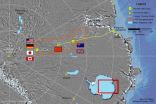(Press-News.org) Scientists working in the remotest part of Antarctica have discovered that liquid water locked deep under the continent's coat of ice regularly thaws and refreezes to the bottom, creating as much as half the thickness of the ice in places, and actively modifying its structure. The finding, which turns common perceptions of glacial formation upside down, could reshape scientists' understanding of how the ice sheet expands and moves, and how it might react to warming climate, they say. The study appears in this week's early online edition of the leading journal Science; it is part of a six-nation study of the invisible Gamburtsev Mountains, which lie buried under as much as two miles of ice.
Ice sheets are well known to grow from the top as snow falls and builds up annual layers over thousands of years, but scientists until recently have known little about the processes going on far below. In 2006, researchers in the current study showed that lakes of liquid water underlie widespread parts of Antarctica. In 2008-2009, they mounted an expedition using geophysical instruments to create 3-D images of the Gamburtsevs, a range larger than the European Alps. The expedition also made detailed images of the overlying ice, and subglacial water.
"We usually think of ice sheets like cakes--one layer at a time added from the top. This is like someone injected a layer of frosting at the bottom--a really thick layer," said Robin Bell, a geophysicist at Columbia University's Lamont-Doherty Earth Observatory and a project co-leader. "Water has always been known to be important to ice sheet dynamics, but mostly as a lubricant. As ice sheets change, we want to predict how they will change. Our results show that models must include water beneath." The Antarctic ice sheet holds enough fresh water to raise ocean levels 200 feet; if even a small part of it were to melt into the ocean, it could put major coastal cities under water.
The scientists found that refrozen ice makes up 24% of the ice sheet base around Dome A, a 13,800-foot-high plateau that forms the high point of the East Antarctic ice sheet, at 3.8 million square miles roughly the size of the continental United States. In places, slightly more than half the ice thickness appears to have originated from the bottom, not the top. Here, rates of refreezing are greater than surface accumulation rates. The researchers suggest that such refreezing has been going on since East Antarctica became encased in a large ice sheet some 32 million years ago. They may never know for sure: the ice is always moving from the deep interior toward the coast, so ice formed millions of years ago, and the evidence it would carry, is long gone.
Deeply buried ice may melt because overlying layers insulate the base, hemming in heat created there by friction, or radiating naturally from underlying rock. When the ice melts, refreezing may take place in multiple ways, the researchers say. If it collects along mountain ridges and heads of valleys, where the ice is thinner, low temperatures penetrating from the surface may refreeze it. In other cases, water gets squeezed up valley walls, and changes pressure rapidly. In the depths, water remains liquid even when it is below the normal freezing point, due to pressure exerted on it. But once moved up to an area of less pressure, such supercooled water can freeze almost instantly. Images produced by the researchers show that the refreezing deforms the ice sheet upward.
"When we first saw these structures in the field, we thought they looked like beehives and were worried they were an error in the data," Bell said. "As they were seen on many lines, it became clear that they were real. We did not think that water moving through ancient river valleys beneath more than one mile of ice would change the basic structure of the ice sheet."
Because the ice is in motion, understanding how it forms and deforms at the base is critical to understanding how the sheets will move, particularly in response to climate changes, researchers say. "It's an extremely important observation for us because this is potentially lifting the very oldest ice off the bed," said Jeff Severinghaus, a geologist at Scripps Institution of Oceanography in San Diego who was not involved in the study. He said it could either mean older ice is better preserved – or, it could "make it harder to interpret the record, if it's shuffled like a deck of cards."
From November 2008 to January 2009, the researchers did fieldwork around a California-size part of Dome A. Using aircraft equipped with ice penetrating radars, laser ranging systems, gravity meters and magnetometers, they flew low-altitude transects back and forth over the ice to draw 3-D images of what lay beneath. The aim was to understand how the mountains arose, and to study the connections between the peaks, the ice sheet, and subglacial lakes. They were also hunting for likely spots where future coring may retrieve the oldest ice. The work took place near the Southern Pole of Inaccessibility, the point farthest away from any ocean, and much harder to reach than the South Pole itself. They lived in isolated field camps, enduring high winds and temperatures ranging down to minus 40 degrees C.
"Understanding these interactions is critical for the search for the oldest ice and also to better comprehend subglacial environments and ice sheet dynamics," said Fausto Ferraccioli, a scientist with the British Antarctic Survey who also helped lead the project. "Incorporating these processes into models will enable more accurate predictions of ice sheet response to global warming and its impact on future sea-level rise."
The researchers now will look into how the refreezing process acts along the margins of ice sheets, where the most visible change is occurring in Antarctica. Based on their data, a Chinese team also hopes to drill deep into Dome A in the next two or three years to remove cores that would trace long-ago climate shifts. They hope to find ice more than a million years old.
INFORMATION:
Other co-authors of the paper include Timothy T. Creyts, Indrani Das, Nicholas Frearson and Michael Wolovik, of Lamont-Doherty; Hugh Corr, Thomas Jordan and Kathryn Rose of the British Antarctic Survey; David Braaten of the Center for Remote Sensing of Ice Sheets at Kansas University; Detlef Damaske of Germany's Federal Institute for Geosciences and Resources; and Michael Studinger of the NASA Goddard Space Flight Center in Maryland.
The work was funded by the U.S. National Science Foundation and launched in conjunction with the International Polar Year, a 2007-2009 effort to study the poles by thousands of scientists from more than 60 nations. Support also came from the Natural Environment Research Council of Britain; the Australian Antarctic Division; and the Polar Research Institute of China.
Project website:
http://www.ldeo.columbia.edu/res/pi/gambit/
Project website
http://www.antarctica.ac.uk/press/featured/AGAP/hidden_world.php
Background on project:
http://www.earth.columbia.edu/articles/view/2289
Copies of the paper, "Widespread, Persistent Thickening of the East Antarctic Ice Sheet by Freezing from the Base," are available from the authors or from the Science Press Package (www.eurekalert.org/jrnls/sci).
Scientist contacts:
Robin Bell:
(845) 365-8827;
robinb@ldeo.columbia.edu
Fausto Ferraccioli:
+44 (0)1223 221577;
ffe@bas.ac.uk
More information:
David Funkhouser, Lamont-Doherty Earth Observatory
845-365-8708
mobile: 347-753-4816
davidf@ldeo.columbia.edu
Athena Dinar, British Antarctic Survey
+44 (0)1223 221414
mobile: +44 07736 921693
amdi@bas.ac.uk
The Earth Institute, Columbia University mobilizes the sciences, education and public policy to achieve a sustainable earth. Through interdisciplinary research among more than 500 scientists in diverse fields, the Institute is adding to the knowledge necessary for addressing the challenges of the 21st century and beyond. With over two dozen associated degree curricula and a vibrant fellowship program, the Earth Institute is educating new leaders to become professionals and scholars in the growing field of sustainable development. We work alongside governments, businesses, nonprofit organizations and individuals to devise innovative strategies to protect the future of our planet. www.earth.columbia.edu
Lamont-Doherty Earth Observatory, a member of The Earth Institute, is one of the world's leading research centers seeking fundamental knowledge about the origin, evolution and future of the natural world. More than 300 research scientists study the planet from its deepest interior to the outer reaches of its atmosphere, on every continent and in every ocean. From global climate change to earthquakes, volcanoes, nonrenewable resources, environmental hazards and beyond, Observatory scientists provide a rational basis for the difficult choices facing humankind in the planet's stewardship. www.ldeo.columbia.edu
British Antarctic Survey, a component of the Natural Environment Research Council, delivers world-leading interdisciplinary research in the polar regions. Its skilled science and support staff based in Cambridge, Antarctica and the Arctic, work together to deliver research that underpins a productive economy and contributes to a sustainable world. Its numerous national and international collaborations, leadership role in Antarctic affairs and excellent infrastructure help ensure that the UK maintains a world leading position. BAS has over 450 staff and operates five research stations, two Royal research ships and five aircraft in and around Antarctica. www.antarctica.ac.uk
Some Antarctic ice is forming from bottom
Imagery from remote mountains turns normal theory on head
2011-03-04
ELSE PRESS RELEASES FROM THIS DATE:
UCI researchers find new light-sensing mechanism in neurons
2011-03-04
Irvine, Calif. — A UC Irvine research team led by Todd C. Holmes has discovered a second form of phototransduction light sensing in cells that is derived from vitamin B2. This discovery may reveal new information about cellular processes controlled by light.
For more than 100 years, it had been believed that the phototransduction process was solely based on a chemical derived from vitamin A called retinal. Phototransduction is the conversion of light signals into electrical signals in photoreceptive neurons and underlies both image-forming and non-image-forming light ...
Yachting Exclusive: Fraser Yachts Announce New Luxury Yachts for Sale in 2011
2011-03-04
Fraser Yachts is delighted to announce the addition of five new vessels to their ever expanding list of luxury yachts for sale. Built in 1967 and refurbished in 2005, the largest of the new collection is M/Y Il Odyssey yacht. Hailing from the Benetti Yachts shipyard, the Il Odyssey luxury yacht is 37.8m in length and can sleep 9 guests and 6 crew members. She is currently on sale in Monaco for EUR1,950,000.
One of the youngest luxury yachts for sale is M/Y Team VIP yacht. Built in 2010, and built by Guy Couach, this mega yacht is the newest of its siblings of four. ...
Public's budget priorities differ dramatically from House and Obama
2011-03-04
COLLEGE PARK, Md. – When it comes to the federal budget, the public is on a different page than either the House of Representatives or the Obama Administration – with a different set of priorities and a greater willingness to cut spending and increase taxes – concludes a new analysis by the University of Maryland's Program for Public Consultation (PPC).
This new analysis compares the House and administration budget proposals with those produced by a representative sample of U.S. adults. These public budgets were part of an innovative study released last month.
While ...
New observations of the giant planet orbiting beta Pictoris
2011-03-04
Astronomy & Astrophysics publishes new high angular resolution observations of the giant planet orbiting the star beta Pictoris. Located at 63.4 light-years from the Sun, beta Pic is a very young star of about 12 million years old [1], which is 75% more massive than our Sun. beta Pic is well known for harboring an extended and structured circumstellar disk. It was actually the first star to have its disk directly imaged more than 25 years ago. In 2009, a giant planet was seen orbiting within the disk. With an orbital distance of 8 to 15 astronomical units (AU), beta Pictoris ...
26 percent of herbs eaten in Spain are contaminated with bacteria
2011-03-04
A research team from the University of Valencia has discovered that up to 20% of spices and 26% of herbs sold in Spain are contaminated by various bacteria, reducing their quality. The study, which is the first of its kind in Spain, suggests that health and hygiene control systems should be put in place, from cultivation of these products right through to when they reach the market.
Scientists from the University of Valencia have for the first time studied the microbiological quality of 53 samples of spices and herbs such as thyme and oregano sold at Spanish markets.
The ...
How sunlight may reduce the severity of multiple sclerosis
2011-03-04
New research into the neurodegenerative disease, Multiple Sclerosis (MS) offers new insight into the link between sunlight, vitamin D3, and MS risk and severity. The research, published in the European Journal of Immunology, studies the relationship between the sunlight-dependent vitamin D3 hormone, immune cells, and the risk and severity of autoimmunity in an experimental model.
Expensive first-line treatments for MS modestly reduce the frequency of autoimmune attacks but do not slow disease progression, when the patient's immune system operates against the body's own ...
Food forensics: DNA links habitat quality to bat diet
2011-03-04
All night long, bats swoop over our landscape consuming insects, but they do this in secret, hidden from our view. Until recently, scientists have been unable to bring their ecosystem out of the dark but thanks to new genetic techniques, researchers from the University of Bristol and Biodiversity Institute of Ontario, Canada, have been able to reconstruct the environment supporting these elusive creatures.
Working at three sites in Southern Ontario (Canada) the team of students and scientists monitored the diet of little brown bats (Myotis lucifugus) from colonies living ...
Yachts for Sale: YPI Group Announces a Range of Exciting Offers for Spring and Summer 2011
2011-03-04
Each of these luxury yachts measures between 24m and 30m and are able to accommodate at least 8 overnight guests. Far more manoeuvrable and economic these smaller yachts are no less desirable on a luxury yacht charter.
The sailing yacht Rafoly (28.2m) is one the most advanced sailing catamarans available. Launched in 2008 from the Yachts Industries shipyard in Caen, France, she is simple to sail yet gives a feeling of speed similar to that of a performance sailing yacht. Rafoly is able to accommodate 8 overnight guests in her four large cabins, and thanks to her spacious ...
Research into chromosome replication reveals details of heredity dynamics
2011-03-04
A novel study from the Swedish medical university Karolinska Institutet has deepened the understanding of how chromosome replication, one of life's most fundamental processes, works. In a long term perspective these results could eventually lead to novel cancer therapies. The study is presented in the prestigious scientific journal Nature.
By studying DNA replication in yeast cells, researchers at Karolinska Institutet have discovered that a protein complex (Smc5/6) helps to release torsional stress created in the DNA molecule when chromosomes are replicated in preparation ...
The UK maintains a positive outlook, despite the recession
2011-03-04
More than 15,000 adults of working age took part in the survey for Understanding Society, the world largest household panel study funded by the Economic and Social Research Council and run by the Institute of Social and Economic Research (ISER) at the University of Essex. The survey which will follow 40,000 UK households over many years, asks people about a wide range of topics including their employment status, families, income levels and well-being.
It found that people's employment status during the recession had a major impact on how they coped financially. Forty ...
LAST 30 PRESS RELEASES:
Researchers highlight role of alternative RNA splicing in schizophrenia
NTU Singapore scientists find new way to disarm antibiotic-resistant bacteria and restore healing in chronic wounds
Research suggests nationwide racial bias in media reporting on gun violence
Revealing the cell’s nanocourier at work
Health impacts of nursing home staffing
Public views about opioid overdose and people with opioid use disorder
Age-related changes in sperm DNA may play a role in autism risk
Ambitious model fails to explain near-death experiences, experts say
Multifaceted effects of inward foreign direct investment on new venture creation
Exploring mutations that spontaneously switch on a key brain cell receptor
Two-step genome editing enables the creation of full-length humanized mouse models
Pusan National University researchers develop light-activated tissue adhesive patch for rapid, watertight neurosurgical sealing
Study finds so-called super agers tend to have at least two key genetic advantages
Brain stimulation device cleared for ADHD in the US is overall safe but ineffective
Scientists discover natural ‘brake’ that could stop harmful inflammation
Tougher solid electrolyte advances long-sought lithium metal batteries
Experts provide policy roadmap to reduce dementia risk
New 3D imaging system could address limitations of MRI, CT and ultrasound
First-in-human drug trial lowers high blood fats
Decades of dredging are pushing the Dutch Western Scheldt Estuary beyond its ecological limits
A view into the innermost workings of life: First scanning electron microscope with nanomanipulator inaugurated in hesse at Goethe University
Simple method can enable early detection and prevention of chronic kidney disease
S-species-stimulated deep reconstruction of ultra-homogeneous CuS nanosheets for efficient HMF electrooxidation
Mechanical and corrosion behavior of additively manufactured NiTi shape memory alloys
New discovery rewrites the rules of antigen presentation
Researchers achieve chain-length control of fatty acid biosynthesis in yeast
Water interactions in molecular sieve catalysis: Framework evolution and reaction modulation
Shark biology breakthrough: Study tracks tiger sharks to Maui mating hub
Mysterious iron ‘bar’ discovered in famous nebula
World-first tool reduces harmful engagement with AI-generated explicit images
[Press-News.org] Some Antarctic ice is forming from bottomImagery from remote mountains turns normal theory on head





